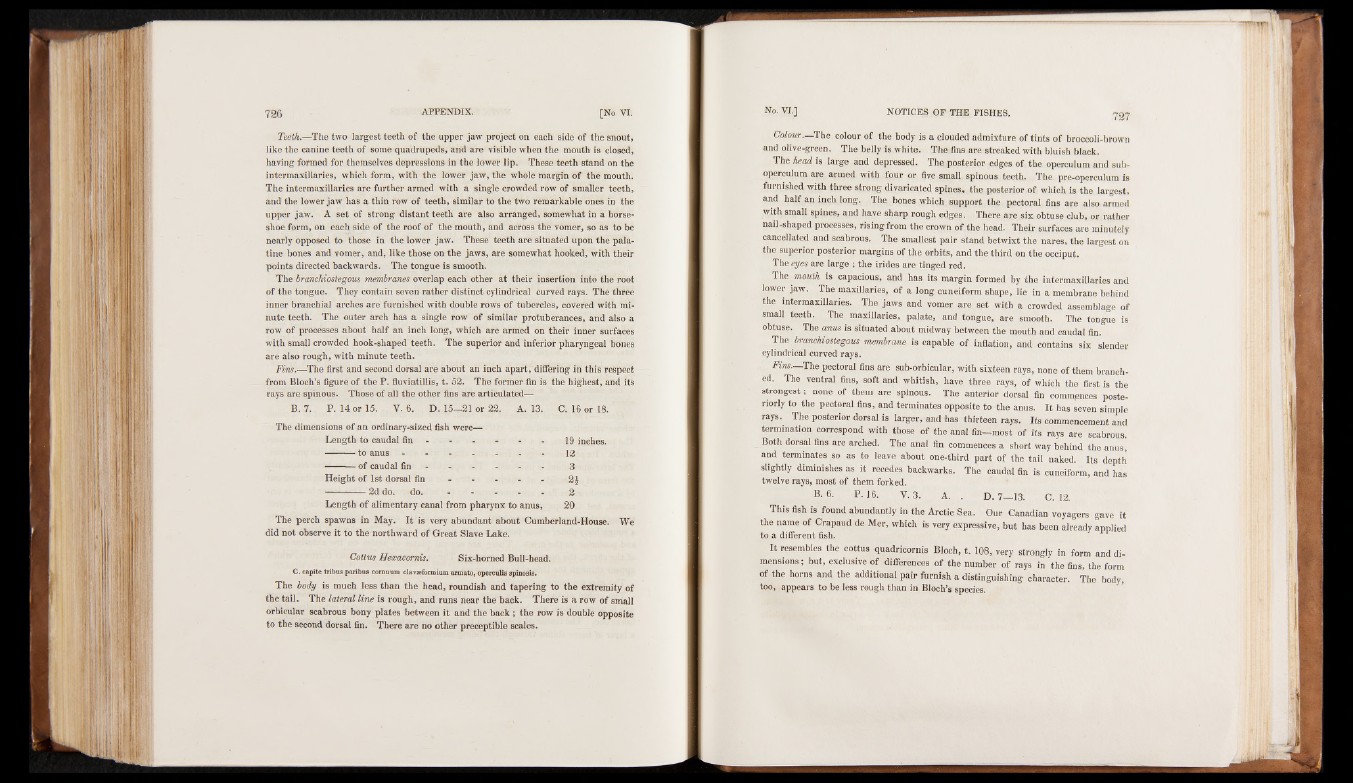
Teeth.—The two largest teeth of the upper jaw project on each side of the snout)
like the canine teeth of some quadrupeds, and are visible when the mouth is closed,
having formed for themselves depressions in the lower lip. These teeth stand on the
intermaxillaries, which form, with the lower jaw, the whole margin of the mouth.
The intermaxillaries are further armed with a single crowded row of smaller teeth,
and the lower jaw has a thin row of teeth, similar to the two remarkable ones in the
upper jaw. A set of strong distant teeth are also arranged, somewhat in a horseshoe
form, on each side of the roof of the mouth, and across the vomer, so as to be
nearly opposed to those in the lower jaw. These teeth are situated upon the palatine
bones and vomer, and, like those on the jaws, are somewhat hooked, with their
points directed backwards. The tongue is smooth.
The branchiostegous membranes overlap each other at their insertion into the root
of the tongue. They contain seven rather distinct cylindrical curved rays. The three
inner branchial arches are furnished with double rows of tubercles, covered with minute
teeth. The outer arch has a single row of similar protuberances, and also a
row of processes about half an inch long, which are armed on their inner surfaces
with small crowded hook-shaped teeth. The superior and inferior pharyngeal bones
are also rough, with minute teeth.
Fins.—The first and second dorsal are about an inch apart, differing in this respect
from Bloch’s figure of the P. fluviatillis, t. 52. The former fin is the highest, and its
rays are spinous. Those of all the other fins are articulated—
B. 7. P. 14 or 15. V. 6. D. 15—21 or 22. A. 13. C. 16 or 18.
The dimensions of an ordinary-sized fish were—
Length to caudal fin - - - - 19 inches.
---------to a n u s .......................................................... 12
---------of caudal fin - - - - - 3
Height of 1st dorsal fin - - - - - 2 |
---------- - 2d do. d o . .......................................2
Length of alimentary canal from pharynx to anus, 20
The perch spawns in May. It is very abundant about Cumberland-House. We
did not observe it to the northward of Great Slave Lake.
Cottus Hexacornis. Six-horned Bull-head.
C. capite tribus paribus comuum clavasformium armato, operculis spinosis.
The body is much less than the head, roundish and tapering to the extremity of
the tail. The lateral line is rough, and runs near the back. There is a row of small
orbicular scabrous bony plates between it and the back ; the row is double opposite
to the second dorsal fin. There are no other preceptible scales.
Colour—The colour of the body is a clouded admixture of tints of broccoli-brown
and olive-green. The belly is white. The,fins are streaked with bluish black.
The head is large and depressed. The posterior edges of the operculum and suboperculum
are armed with four or five small spinous teeth. The pre-operculum is
furnished with three strong divaricated spines, the posterior of which is the largest,
and half an inch long. The bones which support the pectoral fins are also armed
with small spines, and have sharp rough edges. There are six obtuse club, or rather
nail-shaped processes, rising from the crown of the head. Their surfaces are minutely
cancellated and scabrous. The smallest pair stand betwixt the nares, the largest on
the superior posterior margins of the orbits, and the third on the occiput.
The eyes are large ; the irides are tinged red.
The mouth is capacious, and has its margin formed by the intermaxillaries and
lower jaw. The maxillaries, of a long cuneiform shape, lie in a membrane behind
the intermaxillaries. The jaws and vomer are set with a crowded assemblage of
small teeth. The maxillaries, palate, and tongue, are smooth. The tongue is
obtuse. The anus is situated about midway between the mouth and caudal fin.
The branchiostegous membrane is capable of inflation, and contains six slender
cylindrical curved rays.
Fins. The pectoral fins are sub-orbicular, with sixteen rays, none of them branched.
The ventral fins, soft and whitish, have three rays, of which the first is the
strongest; none of them are spinous. The anterior dorsal fin commences posteriorly
to the pectoral fins, and terminates opposite to the anus. It has seven simple
rays. The posterior dorsal is larger, and has thirteen rays. Its commencement and
termination correspond with those of the anal fin-most of its rays are scabrous.
Both dorsal fins are arched. The anal fin commences a short way behind the anus,
and terminates ,so as to leave about one-third part of the tail naked. Its depth
slightly diminishes as it recedes backwarks. The caudal fin is cuneiform, and has
twelve rays, most of them forked.
B. 6. P.16. V. 3. A. . D. 7—13. C. 12.
This fish is found abundantly in the Arctic Sea. Our Canadian voyagers gave it
the name of Crapaud de Mer, which is very expressive, but has to a different fish. been already applied
It resembles the cottus quadricornis Bloch, t. 108, very strongly in form and dimensions
; but, exclusive of differences of the number of rays in the fins, the form
of the horns and the additional pair furnish a distinguishing character. The body,
too, appears to be less rough than in Bloch’s species.